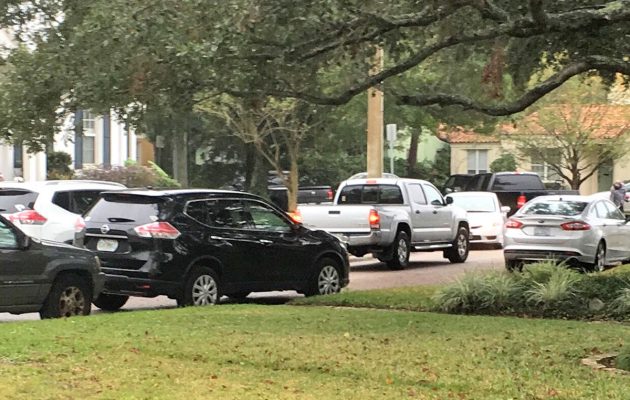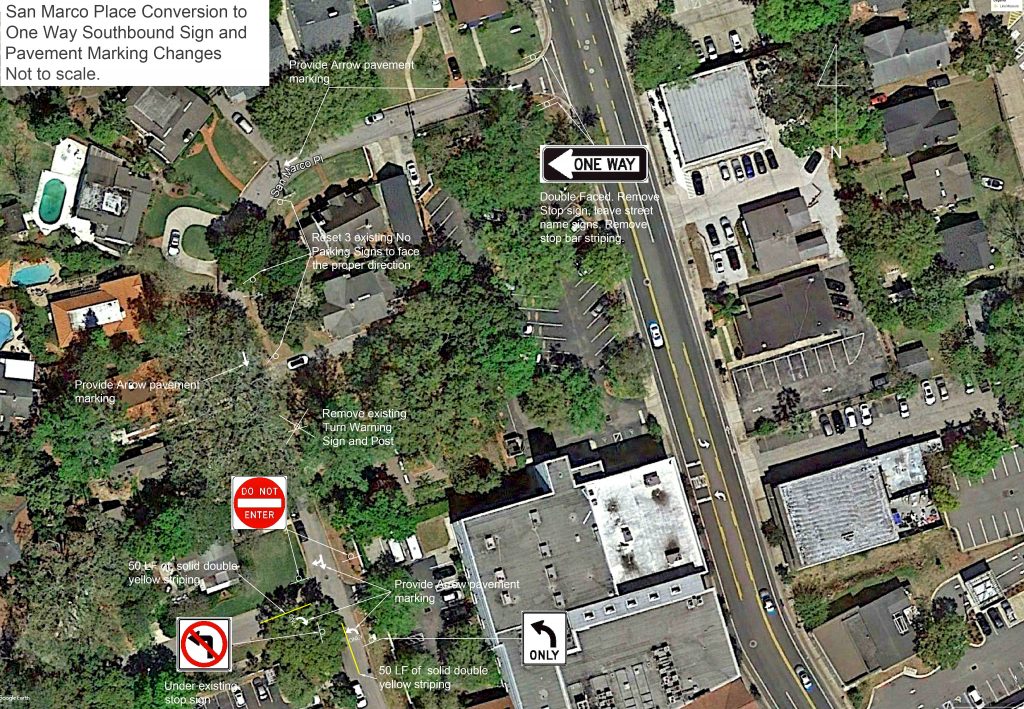Residents balk at city requirement to pay for one-way signage
Posted on August 1, 2019 By Editor Articles, Neighborhood News, San Jose, San Marco, St. Nicholas, Top Stories

To combat the congested mess San Marco Place has become, several residents on that street want the City of Jacksonville to convert their tiny thoroughfare into a one-way street heading south from Hendricks Avenue to Belmont Terrace. They also feel it is “inappropriate” for the City to require property owners to pay a substantial portion of the tab for new signage.
To consider changing San Marco Place from a two-way street to one way requires that 75% of the homeowners sign a petition and that they pay 50% of the cost of the signage, according to the City Traffic and Engineering Department. Although Sandy Myers, a San Marco Place resident, forwarded a request to former District 5 Councilwoman Lori Boyer more than two years ago to convert the street to one way, the city has no plans to make the change at this time, said City Spokesperson Marjorie Dennis. “There are currently no plans to convert San Marco Place to a one-way street. The City performed an evaluation in 2017 at the request of a citizen. Following the evaluation, the requestor was informed about the petition required to continue the process. There was no response,” Dennis said.
It’s a matter of principle, because clearly having two-way traffic with parked cars lining the street is a safety issue, said Bruce Klimek, noting the City converted River Road to one-way between Landon Avenue and Laverne Street, and no homeowners were forced to pay. Even with parked cars lining that portion of River Road, there is more space for two-way traffic to pass than on San Marco Place where on more than one occasion drivers have nearly come to blows after meeting head-on, he said.
In the case of River Road, because Boyer made the request to convert it to one way, residents were not charged, said Dennis. “There was no petition and the City paid the cost. As the road is a popular place for fishing, the signs were placed to reduce congestion,” she said.
“Essentially San Marco Place is a one-way road that people are going both ways on,” said Rick Bouchereau, noting the narrow road was established in the 1920s and is physically unable to accommodate two-way traffic if cars are parked on one or both sides of the street. “I feel like it is the City’s responsibility to make the fix. It doesn’t function as a two-way road right now. This is not really about the money. I think this is something the City really needs to address because it just doesn’t work. God forbid if a fire truck tries to get through here and a car is coming the other way. It’s just not safe.”
San Marco Place has often accommodated overflow parking from patrons of San Marco Square, but when Bold Bean Coffee Roasters opened its doors in October 2016 the situation became much worse. “Every single parking space along the street is occupied all day long every day causing a situation where cars going on opposite directions on the street cannot pass each other, creating a roadblock,” said Klimek.
When Bold Bean first opened, there was an arrangement with Southside Baptist Church for its customers to use the church’s Hendricks Avenue parking lot across the street from the coffeehouse. However, under the advice of attorney Robert Harris of Harris Guidi Rosner, P.A., the church decided it was too much of a liability to allow Bold Bean customers to continue to park in its lot without a crosswalk nearby. “It was just too great a risk for the church to take,” said Dr. Gary Webber, senior pastor of Southside Baptist Church and a San Marco Place resident.

The Florida Department of Transportation is planning to install a mid-block crosswalk across Hendricks Avenue near the entrance of the popular coffeehouse in mid-August, said Sara Pleasants, a FDOT spokesperson.
Soon after the coffeehouse opened, Myers contacted Boyer about the possibility of creating a one-way street or a “permit-parking only” area along the street. “Our street has become a parking lot for Bold Bean to the point where from 6 a.m. to 10 p.m. we never have available area in front of our homes for a visitor to park,” she wrote to Boyer in November 2017. Boyer informed Myers she would look into the matter. Myers assumed things were a go because the City’s traffic and engineering division came out to investigate soon after, and she did not hear anything more about it. Later Myers spoke with Boyer face-to-face and was told “there will never be parking permits in San Marco because the merchants depend on having residential streets available for parking.”
Although Myers did not recall receiving his email, Christopher LeDew of the traffic engineering division, had replied to Myers in November 2017. “If the property owners along San Marco Place want parking restrictions, they will need to complete a petition of the resident’s signatures. This is similar to the ‘one-waying’ request,” he wrote. “The neighborhood would be responsible for the cost of the signage. The interesting wrinkle here is regulating parking ‘By Permit Only.’ Typically, parking restrictions are by time of day, or for a specified time duration. Limiting parking to people holding permits will require a little research on our part. Please allow me some time to answer how the details of issuing permits works.” He also added that he hoped his office had supplied her with information on “one-waying” within the past three weeks as a change of personnel in his office may have caused a delay.
The Resident obtained a copy of LeDew’s response from November 2017 from Boyer’s office. Apparently, there was a miscommunication because Myers said she had received no petitions or information about “one-waying” or anything else at that time. She and Klimek finally received the petitions in February 2019.
When Klimek spoke to John Pappas, director of Jacksonville’s Department of Public Works, at a public meeting at Preservation Hall in January 2019, it became apparent to Pappas the petitions had never been sent out. “Mr. Pappas said it’s more of a safety issue than a convenience issue and that they were 100% behind making the change,” Klimek recalled. “I had pictures of literally six cars backed up trying to go to the corner and six cars coming to go the other way. They were stopped, and there was nowhere for them to turn around. The driveways were occupied by residents’ cars, and there were no empty spaces. Literally they had to back out one by one to a place where they could turn around so the street could be opened. This has happened numerous times.”
Once the petitions finally arrived, Klimek said he and Myers were surprised to learn 11 San Marco Place property owners were responsible for $3,414.50 of the cost. Also, the homeowners would need to work out among themselves how much each would contribute. “Needless to say, this brought the whole process to a screeching halt as far as the neighbors were concerned,” Klimek said. “No way are the residents going to pay more than $3,000 to make this a one-way street. If it’s been identified as a traffic and safety issue by the director of public works, why should the residents have to pay a penny of it? It’s the job of the City to protect its citizens and make the traffic as safe as possible.
“We were naïve twice. We were naïve in thinking when we communicated this to City Council that it was a done deal,” he continued. “What we didn’t know is that it went to the traffic department, who looked at the street, did their analysis/survey and then didn’t do anything about it. So, all the interested parties, except for the traffic people, thought this was an ongoing project. I’m not blaming anybody – I don’t know what happened – but fat, dumb and happy we sat here waiting for people to come out and make it into a one-way street and that never happened,” Klimek continued. “We were very surprised when we bumped into Lori Boyer at that meeting (January 23) and her exact words were, ‘That’s not done? I thought that was finished.’”
According to the City Traffic and Engineering Department, “it is quite rare for streets to be changed from two-way to one-way. As such, the City does not have a specific policy or procedure,” wrote Dennis in an email. “Instead, we rely on engineering judgment to determine roadway functions. When it comes to charging residents for infrastructure changes, we follow existing policies that are similar. Changing San Marco Place to one-way can be considered a ‘traffic calming’ change. In our traffic calming policy, we charge residents for the cost of speed humps and speed limit signs. Where these traffic calming strategies are placed in a neighborhood with cut-through traffic from outside of the neighborhood, the City charges residents 50% of the cost. Upon review, we believe that San Marco Place similarly experiences cut-through traffic and should be subject to a 50% cost reduction. The cost estimate is $3,414.50, so the revised charge to residents will be $1,707.25.”
Although Dennis advised The Resident of the cost reduction, the City did not inform Klimek or his neighbors of it. When informed of the change in cost by The Resident, Klimek, Bouchereau, and Webber said if their neighbors are willing to pay $170 apiece, they would too, but because it’s been determined as a traffic safety issue, the residents should not, on principle, be charged.
“If the City recognizes a safety issue, it seems it’s incumbent upon them to address that issue because if we go to a situation where all the residents on any given street are responsible to pay to have a safety issue addressed, are we going to apply that across the entire city?” Webber asked. “I thought that was what we paid taxes for. If this is the case, and this is becoming a practice city-wide, I think it’s important to have a larger conversation to see if this is a wise practice. If it’s a safety issue and the residents don’t pay, is the City willing to allow the safety issue to continue? What about neighborhoods where the residents can’t afford to pay? Do you then leave a road unsafe? This is a real safety issue and to compound it, San Marco Place is a high pedestrian area and there’s no sidewalk,” he said, noting City officials have indicated they want to make Jacksonville a “pedestrian-friendly” city. “If the residents say, ‘We’re not going to pay for it,’ is the City willing to put pedestrians at risk who do not live on this street?”
Webber added he has personally broken up fights between irate motorists who chanced a head-on collision due to their inability to negotiate around the parked cars. “I think City officials would be surprised if they saw how much traffic and how many people use this little road – and it’s not just cars, it’s pedestrians too. This is a major thoroughfare for pedestrians.”
By Marcia Hodgson
Resident Community News




 (No Ratings Yet)
(No Ratings Yet)city of jacksonville, City Traffic and Engineering Department, One-way Street, San Marco Place





